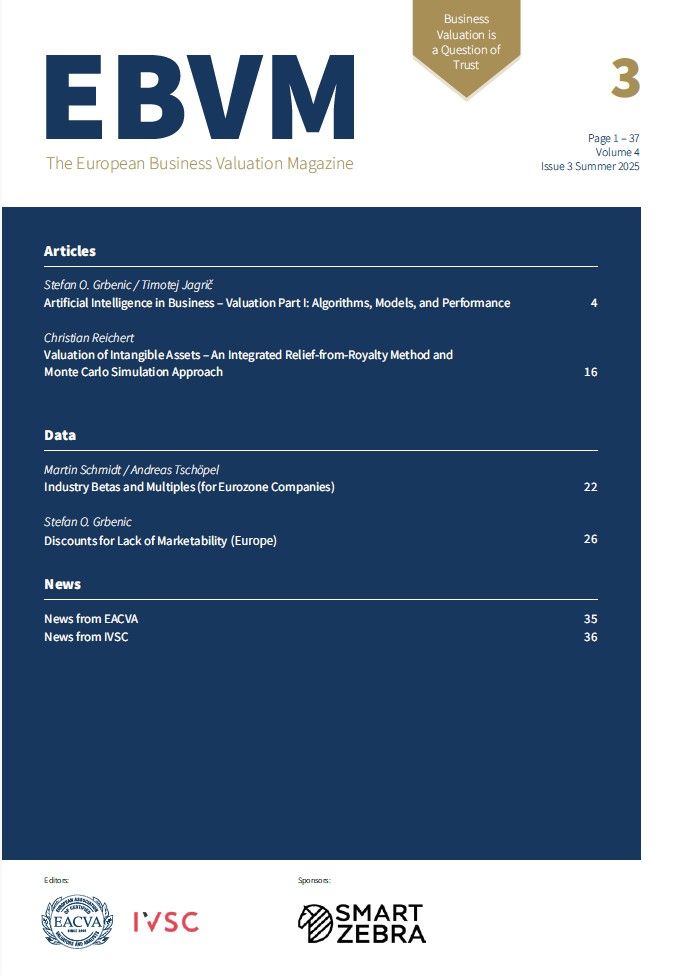European Business Valuation Magazine
Issue Summer 2025

The European Association of Certified Valuators and Analysts (EACVA) and the International Valuation Standards Council (IVSC) are pleased to present the 12th issue of the new European Business Valuation Magazine (EBVM), published in June 2025.
- Editorial: AI, Governance, and Expertise: Navigating the New Frontier in Business Valuation
Wolfgang Kniest, CVA - Artificial Intelligence in Business Valuation – Part I: Algorithms, Models, and Performance
Prof. Dr. Stefan O. Grbenic, StB, CVA / Prof. ddr. Timotej Jagrič, CQRM - Valuation of Intangible Assets – An Integrated Relief-from-Royalty Method and Monte Carlo Simulation Approach
Dr. Christian Reichert, CVA, MBA - Data: Industry Betas and Multiples (for Eurozone Companies)
Dr. Martin H. Schmidt / Dr. Andreas Tschöpel, CVA, CEFA, CIIA - Data: Discounts for Lack of Marketability (Europe)
Prof. Dr. Stefan O. Grbenic, StB, CVA - News from EACVA
- News from IVSC
Abstracts
The rapid evolution of artificial intelligence (AI) and digital transformation continues to reshape the business valuation profession. As valuers, we are challenged to adapt our methodologies, safeguard professional judgment, and embrace innovation responsibly. This issue places a strong focus on these developments and their implications for practice. In July 2025, the International Valuation Standards Council (IVSC) published its perspective paper “Navigating the Rise of Artificial Intelligence in Valuation: Opportunities, Risks, and Standards.” This paper sets a clear framework: AI offers significant potential for efficiency, deeper analysis, and broader access to data, but cannot replace the independent professional judgment of the valuer. The new IVS, effective January 2025, reinforce the principles of governance, transparency, and accountability—reminding us that automated valuation models must remain subject to expert oversight to ensure compliance and trust in outcomes.
Building upon this broader regulatory perspective, the article by Prof. Stefan O. Grbenic and Prof. Timotej Jagrič, “Artificial Intelligence in Business Valuation – Part I: Algorithms, Models, and Performance,” provides a profound introduction into the mechanics of AI, with particular focus on machine learning algorithms and their applicability to valuation practice. Their contribution highlights the opportunities for greater efficiency and predictive power, while stressing the continued necessity of human expertise to interpret, guide, and ethically apply AI-generated insights.
Complementing this focus on innovation, Dr. Christian Reichert’s article “Valuation of Intangible Assets – An Integrated Relief-from-Royalty Method and Monte Carlo Simulation Approach” addresses one of the most challenging areas of modern valuation practice: intangible assets. By combining the well-established Relief-from-Royalty method with Monte Carlo simulation, his work illustrates how probabilistic approaches can enhance the robustness of valuation outcomes and better support decision-making under uncertainty. The case study presented demonstrates the practical relevance of this methodology, especially in contexts with limited or uncertain data. Both contributions underline the dual imperative facing our profession: to integrate new analytical tools responsibly while safeguarding the core values of independence, transparency, and sound judgment. I warmly encourage you to explore these articles in depth. They not only expand our technical toolkit but also inspire us to reflect critically on the future of
valuation in an increasingly data-driven environment.
I invite you to engage with these thought-provoking contributions, discuss them with colleagues, and consider how their insights might inform and enrich your own professional practice. Together, by combining innovation with prudence, we can continue to strengthen the credibility and relevance of business valuation in a rapidly changing world.
Wolfgang Kniest, CVA
Part I: Algorithms, Models, and Performance
This article examines the application of Artificial Intelligence in business valuation. It is divided into two parts: This part one gives an overview on AI (especially Machine Learning) models and algorithms, model performance optimization, learning paradigms, data inference, algorithm tasks as well as types of variables captured, and describes the basics of different types of common algorithms categorized according to functions and similarities. Built upon these basics, the upcoming part two provides an overview on the primary tasks AI (Machine Learning) algorithms have been applied in business valuation research currently emphasizing predictive (rather than generative) algorithms, including their capability to predict company values directly (stand-alone or automated valuation approach), their capability to identify explanatory variables in predicting company values, their performance in selecting peers forming a peer group, and their performance to develop information extraction systems of financial data for business valuation purposes. In general, the research results allow for the overall conclusion that AI (Machine Learning) techniques are a promising way to improve the business valuation profession.
– An Integrated Relief-from- Royalty Method and Monte Carlo Simulation Approach
This article explores the synergies between Relief-from-Royalty Method (RFR) and Monte
Carlo Simulation (MCS), highlighting the advantages of this combined approach in the valuation
of intangible assets and illustrating how it can enhance the strategic decision-making
process in the face of uncertainty. For illustration purposes, a full calculation example for a
technology-related intangible asset in Germany is presented after a detailed explanation of
the methodological approach.
All data has been obtained from the KPMG Valuation Data Source. The data source provides access to cost of capital parameters from more than 150 countries and sectors as well as peer-group-specific data from over 16,500 companies worldwide. The data covers the period from 2012 to the present. The data is updated monthly and is accessible from anywhere around the clock. See KPMG Valuation Data Source for details.
Over the years, a variety of Option Pricing Models (hereinafter OPM) have been introduced to estimate Discounts for Lack of Marketability (hereinafter DLOM), capturing the key value drivers stock price volatility, period of illiquidity, and dividend yield. The DLOM are computed employing three OPM generally proved to generate DLOM estimates that comport with DLOM empirically observed on the European market according to varying assumptions about the period of illiquidity, the size of the underlying DLOM benchmarks, the volatility of the underlying stock return and, the dividend yield (employing closed-form solution formulae).
The computations are based on stock and company data directly collected from the stock exchanges as well as from yahoo!finance.